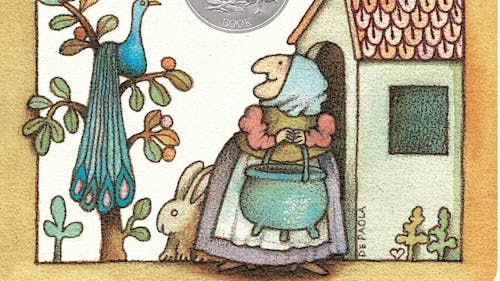Legacy of Tomie dePaola: College student’s ode to her favorite children’s books

Tomie dePaola was a children’s author and illustrator of more than 200 books who died on March 30. Using both his words and artistic talents, dePaola enriched his novels with his own experiences and ideas about family. His stories colored the childhoods of thousands across the United States, and he won awards like the 2000 John Newbery Medal and was a runner-up for the 1976 Caldecott Medal.
For those of you that didn’t have very invested public school librarians — for some reason I seemed to have a library period up until the fifth grade — the John Newbery Medal and Caldecott Medal are high-level American Library Association awards and are just a fraction of the praise dePaola received throughout his career.
At the crossroads of simultaneously mourning the loss of one of my forgotten favorite authors and, somehow, my childhood, I reread a few of dePaola’s most celebrated works. Here’s a list of three of the author’s best works:
"Strega Nona"
The character of Strega Nona (or "Grandma Witch") is a well-known town witch who townspeople went to see for headaches, and husbands and warts. Due to her old age, she decides to employ a younger person for help. Big Anthony, a young person from the town, starts doing chores for Strega Nona in exchange for food and lodging. The only real rule is, Big Anthony is forbidden to touch Strega Nona’s pasta pot.
It turns out the pot is actually a magic pot that can create pasta without any ingredients, but of course Big Anthony does the one thing he was precisely told not to do, and messes with Strega Nona's pot. Big Anthony informs all of the townspeople of the pot, makes everyone pasta, but can’t turn off the pasta-making. The whole town becomes flooded with pasta, but Strega Nona arrives just in time to save the day. As a punishment, Big Anthony has to eat all of the pasta.
The story is hilarious and memorable, while also very profound. The author introduced concepts like responsibility and trust to a young audience in a visually engaging way. I can still remember the sound of my first-grade teacher’s voice and a magical Strega Nona alongside her pasta pot, and her story is told and retold in an unceasing loop.
"26 Fairmount Avenue"
In an almost-autobiography, DePaola writes about a young boy named Tomie and his family’s life in the town of Meriden, Connecticut. The story describes growing up in the late 1930s, experiencing the anticipation of a hurricane and some of Young Tomie’s extended Irish-Italian family. A few of the themes explored include acceptance and the importance of family.
Throughout the novel, it's clear that community means everything to the dePaola family. This is an important value to pass onto future generations and to even think about now. In an increasingly individualistic society, it's far too easy to forget to appreciate the presence of others.
One particular moment I enjoyed about the novel was when Young Tomie mistook chocolate laxatives for normal chocolate, and found out about it the hard way. The story even describes real history, like Young Tomie seeing “Snow White and the Seven Dwarfs” in theatre for the first time.
"Now One Foot, Now the Other"
This is by far my favorite of dePaola’s work, but it's not one of the author’s most popular books. In the novel, a young boy named Bobby and his grandpa Bob are inseparable pals. In addition to playing with blocks and taking strolls together, one of the most beautiful memories the two share with each other is Bob helping his grandson learn how to walk. Bob encourages his young grandson to walk by saying, “Now one foot, now the other.”
Eventually due to a stroke, Bob cannot walk or even remember Bobby. At first, Bobby is far too afraid to speak to his grandfather and doesn’t understand the sudden change in his closest friend.
Bobby eventually gets his grandpa to recognize him and regains some of his memory by playing the games the two played in a particular order. Bobby helps his grandfather re-learn how to walk by encouraging him with the words “Now one foot, now the other.”
Talk about a first-grade tearjerker.
More than anything, this story is undeniably emotional. Teaching this level of extraordinary empathy is crucial for children. This beautiful relationship between a grandfather and his grandson is irreplaceable, highlighting the importance of family bonds.
DePaola’s name slipped to the hidden crevices of my mind up until I read that he died, but somehow every now and then moments from his stories came to me. Aluminum and silver-wrapped chocolates will forever remind me of the laxatives from “26 Fairmount Avenue," perhaps a testament to a bittersweet childhood.
Some of dePaola’s best characters were his oldest, especially Strega Nona. The elderly in our society are rarely the heroes of our stories, which was not the case in dePaola’s stories. Now more than ever, it’s important to appreciate and honor the elderly figures in our lives.



